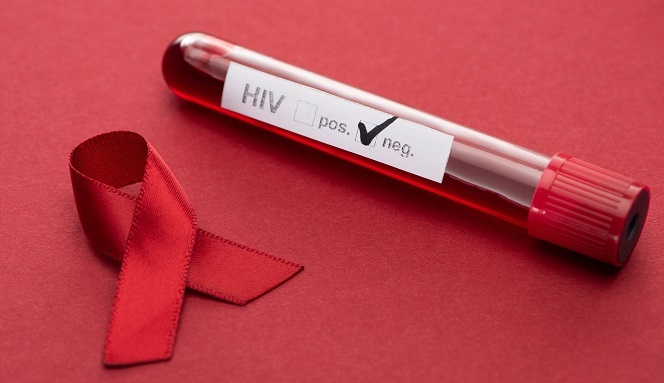
 Data Structure
Data Structure Networking
Networking RDBMS
RDBMS Operating System
Operating System Java
Java MS Excel
MS Excel iOS
iOS HTML
HTML CSS
CSS Android
Android Python
Python C Programming
C Programming C++
C++ C#
C# MongoDB
MongoDB MySQL
MySQL Javascript
Javascript PHP
PHP
- Selected Reading
- UPSC IAS Exams Notes
- Developer's Best Practices
- Questions and Answers
- Effective Resume Writing
- HR Interview Questions
- Computer Glossary
- Who is Who
What is the full form of HIV?
Introduction to HIV
Human Immunodeficiency Virus (HIV) that belongs to the retrovirus group that works in the reverse direction by changing its RNA into DNA and inserts itself into human DNA. It causes the infection by affecting the cells of the human body. It weakens the body to fight against any infections and diseases.

The disease cannot be transmitted but the virus can be transmitted from one person to another. There is no cure for the disease but medications can slow down the progress of the disease.The virus severely damages the immune system and patients with AIDS have very low white blood count.
The virus initially spread in AFRICA in late 1970's among chimpanzees and then in humans. Studies have shown that currently about 40 million people around the world are affected with the disease.
Transmission and Prevention of HIV
HIV is mainly transmitted by exchange of body fluids or if the virus comes into contact with a permeable barrier in the body like small cuts or wounds. The other modes of transmission are
Sexual transmission from an infected person to the partner when condoms are not used. Seminal fluid, vaginal fluid, rectal fluid transmits the virus, the virus enters through the vaginal lining,vulva, rectum, penis or mouth through sex.
Mother to child transmission occurs during pregnancy where the infected cells from the mother enter the foetus circulation. It can also pass through breast milk after delivery.
Blood transfusion from infected person
Needle or injection sharing during drug usage with the contaminated blood from an infected person can transmit the virus.
Health care providers can accidentally get infected by needle prick while treating the patients.
If the tissues or organs of infected patients are transplanted the recipients will get the virus.
People with other STDs (Sexually transmitted Disease) like syphilis, gonorrhoea, chlamydia or human papillomavirus can acquire the infection from the infected partner.
HIV infection can be prevented by different methods like
Usage of male and female condoms during sexual contact.
People should get tested for sexually transmitted disease and treated as they increase the risk of getting HIV infection.
Preventive medications for HIV like antiretroviral drugs can be taken, they are highly effective and it will prevent the infection upto 90%. This is called Pre Prophylaxis.
Post-exposure prophylaxis treatment can reduce the infection if they are treated immediately after exposure to injection use or exposure of the health care profession to an infected patient.
Use of shared needles, injections, swabs, spoons and injecting equipment should be avoided.
The blood that is used for transfusion should be screened well before use.
Symptoms and diagnosis of HIV
HIV causes infection in various stages and in the final stage it causes a disease called Acquired Immunodeficiency Syndrome (AIDS). The different stages of the infection are
-
Stage 1 - Acute HIV infection
In this stage people do not develop any symptoms or signs and may develop after two to three weeks of the infection. The symptoms are similar to flu or mononucleosis. Some of the common symptoms in this stage are
Cough
Wight loss
Headache
Appetite loss
Night sweats
Open sores in the mouth
Swollen lymph nodes
-
Stage 2 - Clinical latency stage
In this stage the virus becomes dormant and multiplies actively inside the cells. This stage lasts for about eight to ten years depending on the strain and the individual. The CD4 cells are attacked and the person becomes highly contagious of the infection. At the end of the stage the viral load increases by overwhelming the immune cells.
-
Stage 3 - AIDS
The later stage of the infection is AIDS, in this stage the T lymphocytes lose their ability to fight infections. If the CD4 cell count goes below 500 cells/ml then the person is said to have AIDS.

Pneumonia
Brain infection or Toxoplasmosis
Fever, diarrhoea and infection
Yeast infection
Meningitis
Lymphoma
Cancer
Due to low immunity the infected person is exposed to various infections like
Diagnosis for HIV infection is done by doing three different tests using blood samples. The test done are
The antigen antibody test is done to find the antibodies and p24 antigen; a piece of the virus antigen.
HIV antibody test is done on body fluids like saliva, urine and vaginal secretions.it is a rapid test which gives results in 20 minutes.
PCR test to estimate the viral load in blood, this does not come under screening test but helpful when other tests are unclear.
Western blot test ; a confirmatory test for the disease.
Nucleic Acid tests to detect the virus 10 to 33 days after exposure along with other tests like pap smear, CD4 count,chest X ray and viral hepatitis screening is done.
Treatment and Management of HIV
HIV infection cannot be cured but can be controlled with treatments like Highly active antiretroviral therapy (HAART). These therapies are used to stop the replication of the virus and allow the immune system to function and prevent further damage.
A combination of pills and injections are given as the virus can gets resistant easily to the drugs. Some of the drugs used for the treatment are
Protease inhibitors (PIs).
Integrase strand transfer inhibitors (INSTIs).
Nucleoside reverse transcriptase inhibitors (NRTIs).
Fusion inhibitors.
CCR5 antagonists.
The disease can be managed by taking proper medications and regular checkups, this is called adherence treatment.
Conclusion
Human Immunodeficiency Virus (HIV) belongs to the retrovirus group that affects the CD4 cells and the T-lymphocytes of the immune system and causes a condition called AIDS( Acquired Immunodeficiency Syndrome).the condition can not be cured but with the use of medication the viral replication can be stopped and the immune system can heal itself.
FAQ's
Q1. What is Retrovirus?
Ans: Retrovirus is a class of virus that contains RNA as genetic material and it uses an enzyme called reverse transcriptase to insert itself into the host DNA. HIV belongs to this group of viruses; it enters the host cells and destroys its immune system.
Q2. What is the life span of HIV patient?
Ans: There is no particular life span, but if left untreated there are 99% chance for death but with proper treatment and management the life expectancy can be increased.
Q3. how can the mother to child tranmission of the virus can be prevented?
Ans: Effective antiretroviral treatment during pregnancy, delivery and breast feedinds can reduce the risk of transmission by 5%. Immdeiate diagnosis and treatment for infant can reduce the risk of infection and increase life span.

